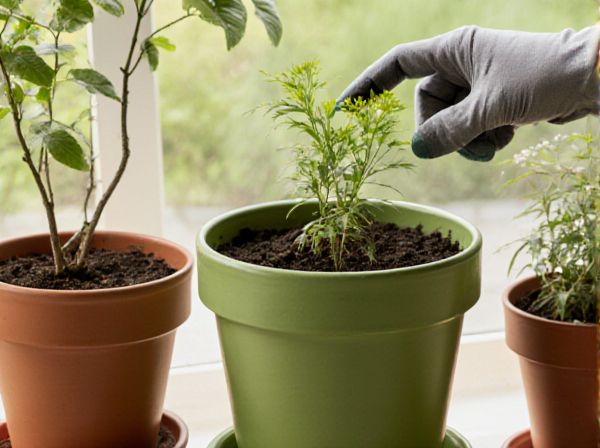
Indoor containers vs outdoor containers Illustration
Indoor containers are designed to be lightweight, decorative, and suitable for controlled environments, often featuring materials like ceramic or plastic that complement interior spaces. Outdoor containers must withstand weather extremes and provide proper drainage, typically made from durable materials such as fiberglass, resin, or heavy-duty plastic. Choosing the right container type ensures plant health and aesthetic appeal tailored to either indoor or outdoor settings.
Table of Comparison
| Feature | Indoor Containers | Outdoor Containers |
|---|---|---|
| Material | Lightweight plastic, ceramic | Durable plastic, metal, wood |
| Drainage | Limited or self-contained drainage | Open drainage for excess water |
| Size | Small to medium | Medium to large |
| Exposure | Controlled environment | Weather-resistant, UV exposed |
| Purpose | Decorative and functional inside plants | Robust growth, landscaping, and gardening |
| Mobility | Easy to move | Often heavy and less portable |
| Maintenance | Cleaned frequently, less exposure | Requires weatherproofing and durability checks |
Key Differences Between Indoor and Outdoor Containers
Indoor containers are typically made from materials like ceramics, plastic, or lightweight metals, designed to regulate moisture and temperature for sensitive plants, while outdoor containers are constructed from more durable materials such as heavy-duty plastic, concrete, or wood to withstand weather elements. Drainage features differ significantly; indoor containers often have limited or no drainage holes to protect indoor surfaces, whereas outdoor containers require ample drainage systems to prevent root rot from rain exposure. Size and weight also vary, with indoor containers generally being smaller and lighter for easy mobility, whereas outdoor containers are larger and heavier to provide stability against wind and environmental stress.
Material Choices: Indoor vs Outdoor Container Types
Indoor containers typically utilize lightweight materials such as plastic, ceramic, or glass, prioritizing aesthetic appeal and ease of handling in controlled environments. Outdoor containers often require durable materials like fiberglass, metal, or reinforced concrete to withstand harsh weather conditions, UV exposure, and temperature fluctuations. Material selection for outdoor containers emphasizes resistance to moisture, rust, and fading, ensuring longevity and robust plant protection.
Size and Shape Considerations for Container Placement
Indoor containers require compact sizes and versatile shapes to fit within limited spaces and accommodate interior design constraints, often favoring square or rectangular forms for efficient use of corners and shelves. Outdoor containers benefit from larger dimensions and robust shapes that withstand environmental factors and optimize garden or patio layouts, with cylindrical and square options offering stability and modular stacking possibilities. Selecting the right container size and shape is crucial for maximizing space utilization and ensuring proper placement in varied indoor and outdoor environments.
Drainage and Watering Needs: Indoor vs Outdoor
Indoor containers require well-draining soil and often need careful watering schedules to prevent root rot due to limited evaporation and lack of natural drainage. Outdoor containers benefit from natural rainfall and exposure to elements, necessitating drainage holes to avoid waterlogging during heavy rains. Proper drainage in both indoor and outdoor containers ensures healthy root aeration and prevents overwatering-related plant stress.
Light Requirements for Plants in Different Containers
Indoor containers require plants that thrive in low to medium light conditions, such as pothos or snake plants, as natural sunlight is limited. Outdoor containers support a wider range of light-loving plants, including vegetables and flowering species, due to direct access to full sun. Selecting containers based on light exposure ensures optimal plant growth and health.
Climate and Environmental Impacts on Containers
Indoor containers benefit from controlled temperature, humidity, and reduced exposure to UV light, significantly minimizing risks of corrosion and material degradation. Outdoor containers face harsh climate conditions such as fluctuating temperatures, rain, snow, and intense sunlight, which accelerate rust formation and structural wear. Environmental factors like salt air in coastal regions and pollution further increase corrosion rates and maintenance costs for outdoor containers.
Best Plants for Indoor vs Outdoor Containers
Indoor containers thrive with low-light, high-humidity plants like snake plants, pothos, and peace lilies, which adapt well to controlled environments and limited sunlight. Outdoor containers benefit from sun-loving, hardy plants such as petunias, geraniums, and marigolds, which tolerate variable weather and direct exposure to the elements. Choosing the right plant species based on container location improves growth, appearance, and container plant health.
Maintenance and Cleaning Tips for Each Container Type
Indoor containers benefit from regular wiping with a damp cloth to prevent dust buildup and occasional use of mild soap to avoid residue that can harm plants. Outdoor containers require more frequent cleaning to remove algae, dirt, and pests; use a brush and a diluted bleach solution to sanitize and prevent mold growth. Ensuring proper drainage and inspecting for cracks or damage in both container types enhances longevity and plant health.
Cost and Longevity of Indoor vs Outdoor Containers
Indoor containers typically cost less upfront due to lightweight materials and simpler designs, while outdoor containers require durable, weather-resistant construction that increases initial expenses. Longevity of outdoor containers is enhanced by UV-resistant coatings and rust-proof metals to withstand varying climates, whereas indoor containers avoid harsh elements, often resulting in longer aesthetic lifespan but potentially less structural durability. Investing in outdoor containers yields better long-term value in exposure-prone environments, whereas indoor containers offer cost efficiency and sufficient durability for controlled settings.
Aesthetic and Design Options for Every Space
Indoor containers offer a wide range of aesthetic and design options, including sleek materials like ceramic, glass, and decorative metals that complement modern interior decor. Outdoor containers prioritize durability with weather-resistant materials such as resin, wood, and concrete, available in diverse styles to suit gardens, patios, and balconies. Both indoor and outdoor container designs cater to various preferences, enhancing the visual appeal and functionality of any space.
Indoor containers vs outdoor containers Infographic

 gardendif.com
gardendif.com